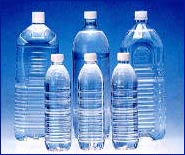Polyethylene Terephthlate (PET) Water Bottles
The
PET bottle exceeds the HDPE bottle in strength, toughness, and clarity.
Filled 1.5-liter bottles dropped on concrete from a height of 6 feet have a
survival rate greater than 97 percent (Hanlon, 1992). The toughness of PET
also allows production of bottles with a wall thickness ranging from 0.010
to 0.020 inches.
PET water bottles are designed for portability, with gripping ribs on the
bottle's lower portion reducing slippage. Popular sizes are 0.5, 1, and
1.5-liters (16.9, 33.8 and 50.7 fluid ounces respectively).
Quality Concerns
Disadvantages of PET water bottles are shrinkage and taste problems. The
empty bottle shrinks if exposed to a temperature around 900 (19SF) (Hanlon,
1992).
At the modular facility, monitor the mold's temperature settings to achieve
good bottle perpendicularity and wall thickness distribution.
At the bottling plant, new bottles should be stored away from heat
generating sources and sunlight. Acetaldehyde, which is found in trace
amounts in PET bottles after production, affects the taste of the water
content especially when the bottles are exposed to elevated heat. Tests show
the presence of a slight fruity taste from a PET bottle which was stored at
490 (120F) for 72 hours. A similar taste was also observed from a year-old
bottle stored at ambient temperature. The intensity of the taste varies
among PET resins.
PET water bottles are packaged in corrugated boxes. Package sizes are
twentyfour 0.5-liter bottles, twelve 1-liter bottles, and twelve 1.5-liter
bottles. Warehousing practices are similar to those for HOPE water bottles:
Two-pallet high, short storage time, and avoid exposing the product to heat.

The 28-mm crown caps are the standard closures of PET water bottles.
Recently, a push-pull dispensing cap was introduced to enhance the package's
portability.
There are variations in the dimensions of the bottle finishes, and
variations in the caps as well, therefore, the fit between the two parts is
sometimes unsatisfactory. It is necessary to monitor the capper for correct
application torque and verify dimensions of bottles and caps regularly to
ensure package quality.
An over tightened cap causes difficulties for consumers, an under tightened
cap may not sufficiently protect the product during transportation and
result in leakage.


 The 28-mm crown caps are the standard closures of PET water bottles.
Recently, a push-pull dispensing cap was introduced to enhance the package's
portability.
The 28-mm crown caps are the standard closures of PET water bottles.
Recently, a push-pull dispensing cap was introduced to enhance the package's
portability.